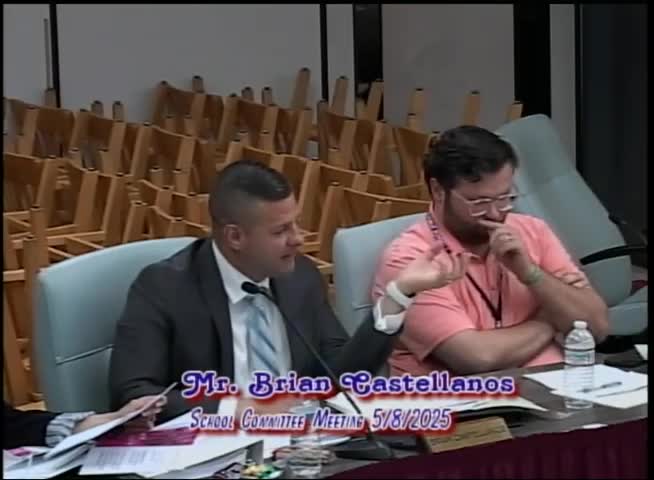Lynn School Board discusses construction impacts and budget concerns for new projects
May 11, 2025 | Lynn Public Schools, School Boards, Massachusetts
This article was created by AI summarizing key points discussed. AI makes mistakes, so for full details and context, please refer to the video of the full meeting. Please report any errors so we can fix them. Report an error »

The Lynn School Committee meeting on May 8, 2025, highlighted significant discussions surrounding the district's construction projects and budgetary concerns, particularly in relation to the new Casa program and the ongoing challenges of overcrowding in local high schools.
A key focus of the meeting was the construction timeline affecting both Casa and the Frederick Douglass Academy (FDCA). Committee members emphasized the importance of understanding how these projects would impact the district's budget, especially as they navigate financial constraints. The furniture, fixtures, and equipment for the new program will be funded through the Lynn Public Schools (LPS) budget, while the construction costs will be covered by the city budget, which counts towards net school spending. This arrangement necessitates a waiver, underscoring the complexities of funding educational initiatives.
Member Satterwhite raised concerns about the affordability of the new program amidst ongoing budget cuts, urging the committee to carefully consider the financial implications of investing in new staff positions and improvements. This sentiment reflects a broader anxiety within the community about balancing innovative educational programs with fiscal responsibility.
Additionally, Member Gailey brought attention to the overcrowding issues at Lynn English and Lynn Classical High Schools, where each institution serves over 2,000 students. Gailey noted that teachers have expressed a need for smaller, more manageable learning environments. The committee discussed the long-term vision of reducing student populations at these schools to around 1,500 each, which would facilitate a more conducive learning atmosphere.
The meeting also touched on the importance of orientation for incoming ninth graders, particularly in light of past experiences with the opening of Frederick Douglass Academy. Ensuring that students and families are adequately prepared for the transition to new educational spaces is a priority for the committee, especially as construction timelines remain uncertain.
In conclusion, the Lynn School Committee's discussions reflect a critical juncture for the district as it seeks to innovate while addressing pressing issues of overcrowding and budget constraints. The outcomes of these conversations will likely shape the educational landscape in Lynn for years to come, as the committee navigates the balance between enhancing educational opportunities and maintaining fiscal health. The next steps will involve further deliberation on funding strategies and construction timelines, as well as continued engagement with the community to address their concerns.
A key focus of the meeting was the construction timeline affecting both Casa and the Frederick Douglass Academy (FDCA). Committee members emphasized the importance of understanding how these projects would impact the district's budget, especially as they navigate financial constraints. The furniture, fixtures, and equipment for the new program will be funded through the Lynn Public Schools (LPS) budget, while the construction costs will be covered by the city budget, which counts towards net school spending. This arrangement necessitates a waiver, underscoring the complexities of funding educational initiatives.
Member Satterwhite raised concerns about the affordability of the new program amidst ongoing budget cuts, urging the committee to carefully consider the financial implications of investing in new staff positions and improvements. This sentiment reflects a broader anxiety within the community about balancing innovative educational programs with fiscal responsibility.
Additionally, Member Gailey brought attention to the overcrowding issues at Lynn English and Lynn Classical High Schools, where each institution serves over 2,000 students. Gailey noted that teachers have expressed a need for smaller, more manageable learning environments. The committee discussed the long-term vision of reducing student populations at these schools to around 1,500 each, which would facilitate a more conducive learning atmosphere.
The meeting also touched on the importance of orientation for incoming ninth graders, particularly in light of past experiences with the opening of Frederick Douglass Academy. Ensuring that students and families are adequately prepared for the transition to new educational spaces is a priority for the committee, especially as construction timelines remain uncertain.
In conclusion, the Lynn School Committee's discussions reflect a critical juncture for the district as it seeks to innovate while addressing pressing issues of overcrowding and budget constraints. The outcomes of these conversations will likely shape the educational landscape in Lynn for years to come, as the committee navigates the balance between enhancing educational opportunities and maintaining fiscal health. The next steps will involve further deliberation on funding strategies and construction timelines, as well as continued engagement with the community to address their concerns.
View full meeting
This article is based on a recent meeting—watch the full video and explore the complete transcript for deeper insights into the discussion.
View full meeting
